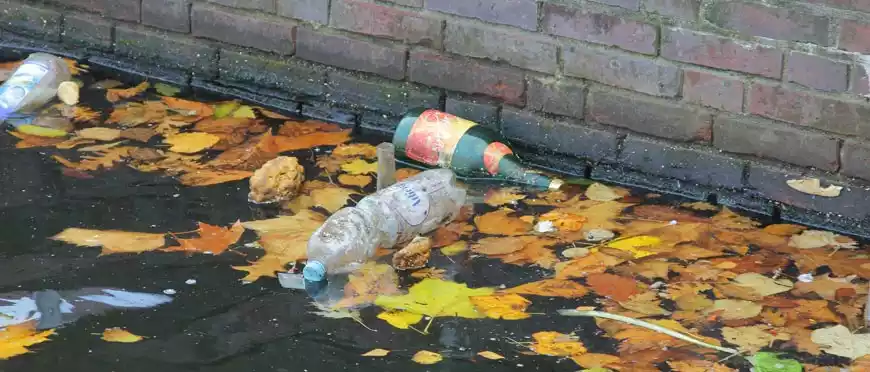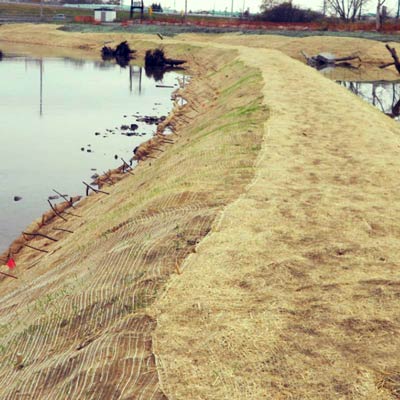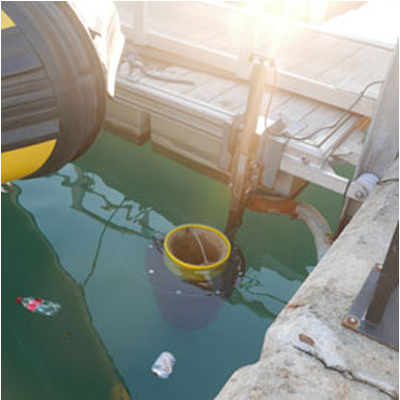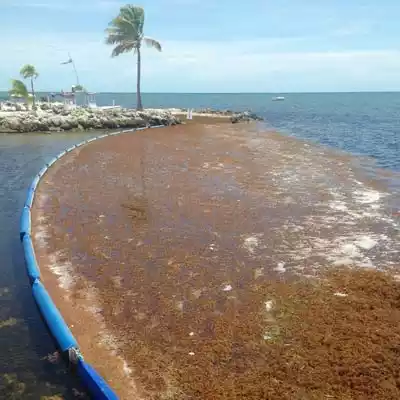Water Pollution Solutions
Seven Simple Solutions for Water Pollution Prevention
Water pollution is caused by many factors including (but certainly not limited to): uncontrolled construction sites, leaking sewer lines, stormwater runoff, accidental spills and leaks, improper discharge of wastes, mining activities, foundries, animal waste, and others. Options for water pollution solutions are equally diverse.
Freshwater is one of the most vital resources for all life on Earth. Much of the water we count on daily for cooking, bathing, and other routine activities is supplied from rivers, lakes, and other surface water sources. However, without widespread care and appropriate protection and treatment systems, our water sources are becoming more and more polluted. As a result of needs that have exceeded funding, there is an ever increasing gap occurring between the amount of public funding available and the measures truly needed for implementing the quantity of water pollution solutions.

Water Pollution Solution #1 - Practice Responsible Use of Fertilizer, Herbicides, and Pesticides
Surface runoff of pesticides, herbicides, and fertilizers into water bodies changes a water body's natural ecosystem. These chemicals can kill plants, insects, and animals in and around the affected waters, as well as create an environment that is costly to recover. Additionally, the reach of the contaminated water is magnified when one considers that water flows from one source to another until it reaches the ocean. With each populated area that contaminated water passes, it picks up more chemicals and pollutants. The polluted water also often makes its way into the water tables and the public water system, which means it's in the drinking water you access.
 The simplest solution for water pollution prevention is to be responsible with any chemical use:
The simplest solution for water pollution prevention is to be responsible with any chemical use:
- Read and explicitly follow the directions for mixing and use.
- Use organic options whenever possible. Check your local stormwater division for suggestions.
- Prevent spills. As spills are generally accidental, prepare in advance to contain and absorb the solution if there is a spill. Having a universal spill kit on hand can be a wise safety measure.
- Don't leave the unused chemicals exposed to weather. Dispose of the leftover chemicals and container properly per the product instructions, or check with your local municipality.
- Do not apply near water systems such as wells, streams, lakes, or curb inlets/drains.
*Note: these guidelines also apply to other chemicals, such as oil and even soaps and detergents.
Water Pollution Solution #2 - Minimize Stormwater Runoff
 Whether a small home-based project or a large commercial construction project with a little advanced planning, you can minimize water pollution from stormwater runoff on your property or site and avoid costly fines. Any soil that's exposed without some sort of erosion control in place is subject to wind and water erosion. Even though sediment erosion is a natural form of water pollution, it has more of an impact than you realize. Sediment in an aquatic environment screens out sunlight, changes the water temperatures, inhibits photosynthesis (which leads to the decline of plant growth), disrupts the food chain, and ultimately leads to a decline of species in the water ecosystem. Depending on the duration of exposure, there are several practical choices available for protecting exposed soil:
Whether a small home-based project or a large commercial construction project with a little advanced planning, you can minimize water pollution from stormwater runoff on your property or site and avoid costly fines. Any soil that's exposed without some sort of erosion control in place is subject to wind and water erosion. Even though sediment erosion is a natural form of water pollution, it has more of an impact than you realize. Sediment in an aquatic environment screens out sunlight, changes the water temperatures, inhibits photosynthesis (which leads to the decline of plant growth), disrupts the food chain, and ultimately leads to a decline of species in the water ecosystem. Depending on the duration of exposure, there are several practical choices available for protecting exposed soil:
- Seed, even if just temporarily, or sod the exposed area.
- Surround the area with properly installed Silt Fence to contain and control the erosion.
Or cover the exposed area with any combination of:
- Natural fabric, such as Coir Coconut Fiber and Straw Netting, blankets or rolls
- Geotextile Fabric
- Rip rap (such as gravel)
*Note: It is best to use an underlayment of geotextile in conjunction with these water pollution solutions.
If you have questions or need assistance, please call 1-863-261-8388 or Contact Us.
Water Pollution Solution #3 - Filter Runoff
Where stormwater lands in ditches or culverts, a check dam or Ditch Check can be used to filter the runoff, preventing sediment pollution and trash from exiting the property. Standing waters such as ponds, trenches, and holding areas can be filtered using Dewatering Products where water is pumped into the bag, capturing any sediment and releasing the water.
Water Pollution Solution #4 - Contain Spills
 Although a small leak from your car or a storage drum may seem minor, it is extremely important to absorb or contain those spills to keep them from entering the watershed as harmful pollutants. Secondary containment berms and basins help catch and contain hazmat leaks and spills for proper disposal. Products such as Foam Wall Spill Berms allow access for vehicles to drive onto the berm to contain leaky vehicles, while there are also Mini Spill Berms to store drums, paint containers, fuel tanks, or other hazmat materials.
Although a small leak from your car or a storage drum may seem minor, it is extremely important to absorb or contain those spills to keep them from entering the watershed as harmful pollutants. Secondary containment berms and basins help catch and contain hazmat leaks and spills for proper disposal. Products such as Foam Wall Spill Berms allow access for vehicles to drive onto the berm to contain leaky vehicles, while there are also Mini Spill Berms to store drums, paint containers, fuel tanks, or other hazmat materials.
Absorbent boom, pads, and socks are another solution for both land based and water spills. While working with ANY hazardous materials, it's smart to always keep Spill Kits and absorbents nearby to quickly absorb oil, chemicals, or fuel. They can be placed on or around spills, or underneath drips to prevent further spreading.
Because oil cannot dissolve in water, spilled oil can turn into sludge which is ingested by marine mammals, clings to feathers of birds, suffocates fish, blocks sunlight for plants, and ultimately impacts the entire food chain. The most publicized oil spills are often those which occur in the ocean, however, freshwater oil spills are much more common and more directly impact humans and our environments. To stop an oil spill in water from spreading, floating containment boom is designed to block the spread of oil and contain it to a manageable area. Once contained, oil skimmers can be used to remove the oil that floats on the water.
If you have questions or need assistance, please call 1-863-261-8388 or Contact Us.
Water Pollution Solution #5 - Protect Curb Inlets and Drains
Storm drains are just for rain! Water that flows into storm drains and down curb inlets usually runs directly into streams, rivers, lakes, and other water sources. This makes protecting storm drains extremely important because that water is not only a habitat to animals and plants, but is also used to supply our drinking water. There are countless products on the market to help filter runoff and protect stormwater drains. Curb guards can be bulky and in the way of cars and pedestrians, but there are invisible traffic-friendly Curb Guard options, too. Drain guards can go over or under the 200-300 lb drain grate, but the Over Grate Drain Filter is safer and easier to use.
Water Pollution Solution #6 - Capture and Dispose of Floating Pollution in Waterway
 Floating pollution can be contained and retrieved relatively easy using a floating boom and Seabin. Boom is designed to act as a barrier for floating water pollution. Depending on how you install the boom, you can either contain, deflect, or exclude floating debris. From trash or seaweed to oil, there are booms to control almost any floating pollutant into a manageable area for disposal. There are Many Ways to Use Boom, but they generally fall under one of two categories: Debris Boom and Oil Boom.
Floating pollution can be contained and retrieved relatively easy using a floating boom and Seabin. Boom is designed to act as a barrier for floating water pollution. Depending on how you install the boom, you can either contain, deflect, or exclude floating debris. From trash or seaweed to oil, there are booms to control almost any floating pollutant into a manageable area for disposal. There are Many Ways to Use Boom, but they generally fall under one of two categories: Debris Boom and Oil Boom.
The Seabin is a floating trash with a catch bag. It pumps debris and plastic from the water's surface, retaining the pollutants and filtering the water through the bag. All debris and trash must be emptied from the Seabin as its becomes full. There are three Seabin models: mobile, fixed, and floating. Each attached to different type of dock for multiple applications.
If you have questions or need assistance, please call 1-863-261-8388 or Contact Us.
Water Pollution Solution #7 - Capture and Filter Sediment Laden Water in Waterways
 Shoreline construction projects disturb and expose soil, creating situations where exposed soil is washed into the nearby water body. This creates murky sediment laden (turbid) water that has a significant negative impact on the marine environment. It harms all of the aquatic life in the area, including plants, fish, insects, and animals. Turbid water can also be created by events that stir up the sediment on the marine floor. For example, a pipe or stream that discharges into a water body at a high velocity stirs up the sediment on the floor and creates turbidity. Dredging projects and in-water construction projects (such as building docks, powerline pylons, etc.) also generate water turbidity that needs to be managed. Turbidity Barriers are the most common solution for controlling sediment filled waters (also known as silt curtains). They are floating barriers designed to contain the turbid water, forcing the sediment to settle in the contained area.
Shoreline construction projects disturb and expose soil, creating situations where exposed soil is washed into the nearby water body. This creates murky sediment laden (turbid) water that has a significant negative impact on the marine environment. It harms all of the aquatic life in the area, including plants, fish, insects, and animals. Turbid water can also be created by events that stir up the sediment on the marine floor. For example, a pipe or stream that discharges into a water body at a high velocity stirs up the sediment on the floor and creates turbidity. Dredging projects and in-water construction projects (such as building docks, powerline pylons, etc.) also generate water turbidity that needs to be managed. Turbidity Barriers are the most common solution for controlling sediment filled waters (also known as silt curtains). They are floating barriers designed to contain the turbid water, forcing the sediment to settle in the contained area.
Further Resources for Water Pollution Solutions and Prevention:
- EPA - Clean Water Rule
- Proposed Regulations for Waters of the United States (WOTUS)
- US Geological Survey
If you have questions or need assistance, please call 1-863-261-8388 or Contact Us.
